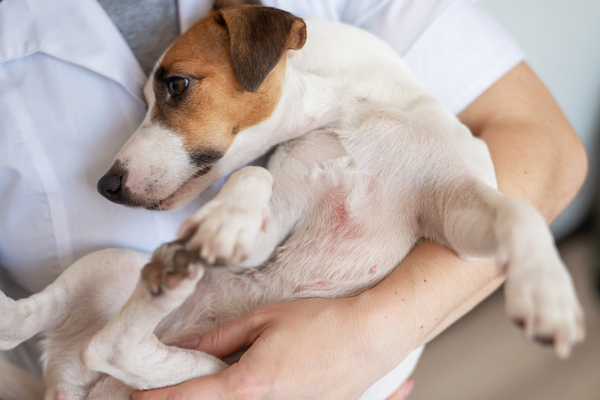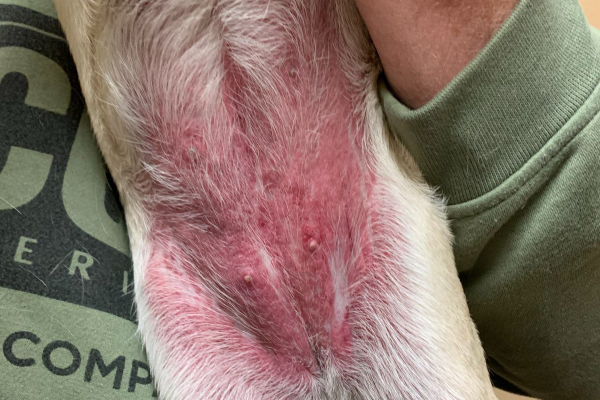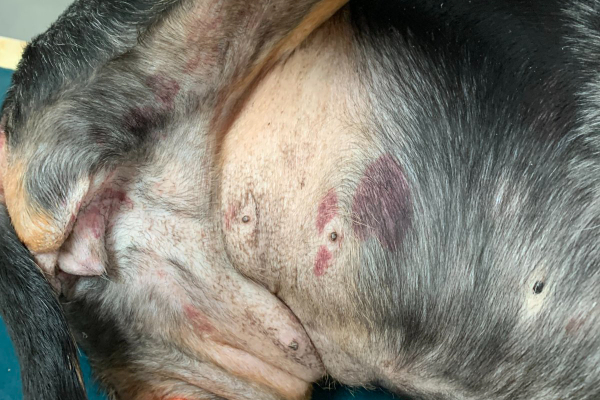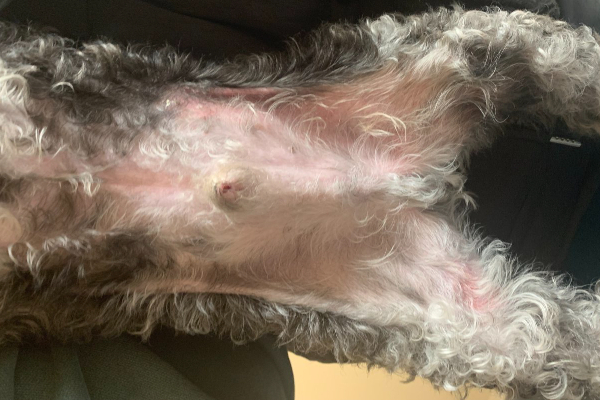Noticing a skin rash on your dog’s stomach can understandably spark concern in many dog parents. To help you navigate this common issue, integrative veterinarian Dr. Julie Buzby discusses what the rash may look like, seven potential causes for the rash, and what to do if you notice a skin rash on your dog’s stomach.

Giving your dog a belly rub might be one of the highlights of your day and your dog’s day too. But what if one day when your dog joyfully flops over for a belly rub, you notice a skin rash on his or her stomach? If you are like many dog parents, noticing a rash on your dog can quickly turn a snuggle session into a stress session.
What is a skin rash?
Broadly speaking, a rash is any sort of redness or irritation over the outermost layer of a dog’s skin. However, the exact appearance can vary. A skin rash may be:
- Tiny red dots or larger red splotches
- Raised or flat
- Itchy or not itchy
- Light pink to darker red
- Scabby, scaly, crusty, dry, pimple-like, bumpy, or smooth
- Painful or non-painful
- Foul smelling or have no abnormal odor
- Covered by the fur or in an area of hair loss
Rashes can occur anywhere on the body. But they are more noticeable in areas where there is naturally little to no fur such as the dog’s stomach, armpits, and groin. Sometimes your dog will just have a rash in one area, such as the belly. But other times it may affect other parts of the body too.
Why do dogs get skin rashes?
Many different conditions, from allergies to immune system disorders, can cause a skin rash on a dog’s stomach or other areas of the body. The following seven diseases or situations may be reasons why your pup’s skin has developed a rash.
7 Causes of a skin rash on a dog’s stomach
1. Environmental allergies or food allergies
Dogs may be allergic to various things in the environment such as pollen, grasses, weeds, and trees. And dogs can also develop food allergies, especially to proteins like meat or soy. First the dog will get itchy. And then as a result of the dog licking, scratching, biting, and otherwise traumatizing the skin, the dog may develop a secondary bacterial skin infection (i.e. pyoderma in dogs) or yeast infection.

Often the infection causes a red, itchy skin rash. The rash may be confined to one area such as the dog’s belly or armpits. Or it may extend over much of the dog’s skin.
Sometimes instead of a more widespread skin condition, the dog could also develop a dog hot spot. This is a solitary area of reddish to yellowish moist painful skin which shows up rapidly. Additionally, dogs with allergies may be prone to ear infections (i.e. otitis in dogs) or dog anal gland issues.
2. Contact dermatitis
Rather than having a systemic allergic reaction to an allergen, dogs can also have a localized contact reaction to chemical irritants or plants that touch their skin. This could be a floor cleaner, detergent, lawn fertilizer, or other chemical. Plus, plants such as poison ivy and poison oak can cause itchy skin rashes in some dogs.
Rashes due to a contact reaction (i.e. contact dermatitis) generally occur on poorly-haired areas of skin such as the belly, feet, and groin. These are also the areas that would be the most likely to come in contact with the irritant. Other areas of the body are better protected due to thicker fur or not in a location that frequently contacts the ground.
3. Parasites
A variety of parasites can cause rashes in dogs. Fleas are one of the most common external parasites. Some dogs develop flea allergy dermatitis or FAD (i.e. an allergy to flea saliva that causes skin problems). FAD tends to show up as a bumpy itchy rash on a dog’s lower back and stomach. This is why it is important to prevent fleas when possible and to understand how to know if your dog has fleas. Plus, other parasites like sarcoptic mange and demodectic mange can cause skin rashes and hair loss too.
Although not a true parasite, the black fly is also worth mentioning. Black flies can bite dogs, causing multiple dark circular skin rashes on your dog’s belly. Black flies are more active in the early summer, and they breed in running water. Therefore, it is best to avoid rivers and streams during May and June.
4. Skin infections
Just like in humans, there are naturally-occurring bacteria and yeast on a dog’s skin. These microorganisms are not a problem on the skin’s surface normally. But itching, trauma, or other diseases can cause a breakdown in the skin’s barrier abilities. Plus, they decrease skin health. As a result, bacteria and yeast can get a foothold to cause bacterial infections and yeast infections on a dog’s paw or elsewhere. Plus, other invaders like the fungi that cause ringworm can also attack the skin.

A skin infection tends to look like a rash which may be red, scabby, flaky, or crusty. Sometimes you may see little pustules (i.e. pimples). While the rash may be anywhere on the dog’s body, it is a lot easier to see on the belly, armpits, groin, or inner thighs. If the feet are involved, the dog may also have itchy dog paws or interdigital cysts in dogs.
5. Hormonal imbalances
A dog’s endocrine system is in charge of releasing hormones, which are chemical messengers signaling various functions in the body. When there is too much or too little of a certain hormone, the dog may develop skin issues.
Cushing’s disease in dogs (i.e. excess production of the hormone cortisol) can cause flaky skin, poor hair growth, and sometimes a rash on a dog’s stomach. The same is true for dogs with insufficient thyroid hormone (i.e. hypothyroidism in dogs). Hypothyroidism can also cause hyperpigmentation, a darkening of the skin that may look like a brown rash. Strictly speaking, it isn’t a rash, though.
6. Autoimmune disorders
An autoimmune disorder is a type of illness where the immune system mounts an inappropriate response against healthy cells in the body. Examples of autoimmune conditions that can cause dog belly rashes and skin problems in other areas include systemic lupus erythematosus in dogs and some forms of pemphigus.
Additionally, immune-mediated thrombocytopenia (ITP in dogs) and other causes of low platelets in dogs can cause pinpoint bruises (petechia) or larger bruises (ecchymoses) on a dog’s skin due to spontaneous bleeding. This may look like a flat red to purple rash. ITP can be life-threatening. So if you see bruising on your dog’s belly, inner ears, gums, or anywhere else, please make an emergency vet visit.

7. Heat and humidity
Especially when it is hot and humid, moisture can get trapped in a dog’s skin folds and cause irritation. This tends to happen in dog breeds with more skin folds or overweight dogs. As the hot moist skin folds rub against each other, the skin may become red, painful, or develop a rash.
The skin folds are also a perfect environment for bacteria and yeast to thrive. So secondary infections commonly accompany a heat rash.
What should you do if you see a skin rash on your dog’s stomach?
It is best to contact your veterinarian if you are seeing signs of a rash on your dog’s stomach or elsewhere on the skin. He or she can perform a physical exam, assess the rash, and carry out any necessary diagnostics.
For example, vets often perform a skin cytology for dogs with a belly rash. This simple in-clinic diagnostic test involves collecting a sample from the affected area of the skin. Then the vet will examine the sample under the microscope for bacteria or yeast. This information can help your vet determine how best to treat your dog’s rash.
What is the treatment for a rash on a dog’s stomach?
Treatment will depend on the results of the cytology or other diagnostics and the severity of the rash. Dogs with minor itchiness and a rash that only covers a small area may only need topical therapies like ointments, sprays, or wipes.
But bigger skin rashes or more significant infections or itchiness may require systemic treatment as well as topical treatment. The dog might need oral antibiotics or antifungals, allergy medicine for dogs like Apoquel® or Cytopoint®, or other medications. Plus, they still benefit from topical therapies like medicated shampoos, sprays, or mousses.
Additionally, if the vet suspects an underlying endocrine disease and confirms it with blood tests for dogs, he or she will also start the dog on medication to control the Cushing’s disease or hypothyroidism. Or in the case of external parasites, he or she may use anti-parasitic medications to control fleas, scabies, or demodex.

Finally, if your dog is scratching or licking the area with the rash, sometimes your vet will recommend using an Elizabethan collar or other lick-deterrent. This helps protect the skin from further trauma while it heals.
Track your dog’s progress and follow up with the vet when recommended
In order to determine if treatment is working, you will need to follow up with your veterinarian periodically. It also helps to take photos of the rash each day so you can track the healing process. If the skin rash isn’t resolving, the vet may recommend additional diagnostics such as allergy testing, skin biopsies, or cultures to get to the root of the problem.
Are there home remedies for dog skin rashes?
While waiting for a vet appointment, there are several home remedies you can try to help your dog in the meantime. However, it is important to note that these suggestions are unlikely to resolve anything but a very minor rash on their own. Thus, they are not a replacement for a vet visit. Some potential home remedies include:
- Using topical ointments such as Neosporin® (triple antibiotic) or hydrocortisone cream—after applying a thin layer, distract your dog with a walk or some mental stimulation toys for dogs so he or she doesn’t lick it off
- Bathing your dog with an oatmeal shampoo or anti-itch shampoo—this is soothing and can remove some topical allergens or irritants
- Applying coconut oil, petroleum jelly, or Aquaphor® to the affected area—but in some cases this can trap moisture and actually make the rash worse
- Using aloe vera gel to decrease itching—it is soothing but can be toxic when consumed so don’t let your dog lick it off
While you may have read about apple cider vinegar as another home remedy for skin issues on dogs, it is best to avoid using it. Apple cider vinegar can actually irritate delicate skin, making the inflammation worse.
When you see a skin rash on your dog’s stomach, go see a vet
As you can see, there are a variety of reasons a dog may develop a skin rash. Thus, your vet is the best person to help you figure out how to get your dog’s skin back to normal again. Thankfully, with the exception of ITP, most causes of skin rashes are not immediately life-threatening. Some, like allergies or endocrine disease, may require life-long management, though.
If your dog does develop a skin rash on his or her belly (or elsewhere), scheduling a vet appointment, diligently adhering to your dog’s treatment plan, and following up with your vet as necessary are the best ways to help your dog. With the combination of your dedicated care and your vet’s expertise, you and your dog can soon be enjoying belly rub time again.
What was the cause of the rash on your dog’s stomach?
Please comment below.


My 5 year old straight coat Cavoodle has chronic dermatitis – environmental and this has been an ongoing issue since he was 9 months old. He is on Cytopoint , Neocort Creams and he wears a medical collar to stop licking when severe. He is also on prednisone when he has a severe bout which works a treat but once the course has been completed he begins to itch again after a week . My vet has recommended starting the course again but I fear that this will be a vicious circle . Can a dog continue on half a tablet a day long term as they end the course.? I really don’t know what to do.
Dear Nadia,
I am sorry your pup is experiencing ongoing issues with dermatitis. It is possible for dogs to stay on prednisone long term, but things have to be monitored very closely to ensure it does not start to cause an issue with the liver. It may be time to consider taking your dog to a veterinary dermatologist. They can do allergy testing and help pinpoint the underlying cause of these issues. They can offer desensitization injections/immunotherapy (just like humans get for their allergies) and have a wide range of therapies that may not be readily available in general practice. There are also hypoallergenic foods, collars that help to maintain a healthy skin barrier, supplements and medicated shampoos/sprays/mousse/wipes that can be used daily. I hope you can partner with your vet to find the best solution for everyone involved. Take care and keep up the good work.